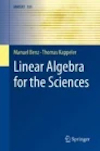- About MAA
- Membership
- MAA Publications
- Periodicals
- Blogs
- MAA Book Series
- MAA Press (an imprint of the AMS)
- MAA Notes
- MAA Reviews
- Mathematical Communication
- Information for Libraries
- Author Resources
- Advertise with MAA
- Meetings
- Competitions
- Programs
- Communities
- MAA Sections
- SIGMAA
- MAA Connect
- Students
- MAA Awards
- Awards Booklets
- Writing Awards
- Teaching Awards
- Service Awards
- Research Awards
- Lecture Awards
- Putnam Competition Individual and Team Winners
- D. E. Shaw Group AMC 8 Awards & Certificates
- Maryam Mirzakhani AMC 10 A Awards & Certificates
- Two Sigma AMC 10 B Awards & Certificates
- Jane Street AMC 12 A Awards & Certificates
- Akamai AMC 12 B Awards & Certificates
- High School Teachers
- News
You are here
Linear Algebra for the Sciences

Publisher:
Springer
Publication Date:
2023
Number of Pages:
271
Format:
Paperback
Series:
UNITEXT
Price:
54.99
ISBN:
978-3031272196
Category:
Textbook
[Reviewed by , on ]
Jer-Chin Chuang
03/30/2024
The book under review is based on lecture notes from a course for first-semester science students at the University of Zurich. Compared to other introductory linear algebra textbooks addressed to broader audiences, this text is rather concise (the main text is less than 190 pages) and is written in a more formal style. Definitions and theorems are carefully stated, and theorems are usually not proved. Written in the traditional mathematical expository style, the general case is usually presented or analyzed before numerical examples are given. Motivation and background are minimal. In the reviewer's experience, this style may be challenging for those not majoring in the mathematical sciences. The authors also do not adopt the convention among introductory texts of distinguishing vectors via boldface font. Each section concludes with 5 problems. The majority are computational in character and similar to earlier worked examples. The inclusion of complete worked solutions would be welcomed by student readers, but they likely will need many more problems both computational and conceptual to internalize the ideas presented.
The topics and order of coverage largely parallel most other introductory linear algebra textbooks, albeit in a more formal and spare style. Complex numbers and complex linear algebra are introduced half-way through the text and utilized in subsequent discussions on eigentheory and linear differential equations. The exposition of the latter is more detailed than usual for a linear algebra text and includes discussion of the non-homogenous case via both variation of parameters and the method of undetermined coefficients. However, some theoretical ideas and themes are oddly missing, e.g. orthogonal complementarity of the four fundamental subspaces, projections, the Gram-Schmidt process, and the increasingly versatile SVD.
In summary, the text seems better suited for mathematically inclined science students, but even then the paucity of applications is curious for a book so titled. Absent are any mention of topics such as finite state Markov chains, linear regression, and PCA as well as more discipline-specific applications such as special relativity and finite state quantum systems. The latter may be a missed opportunity given the extra effort invested covering complex linear algebra. Unfortunately, neither is there a guided further reading section that enumerates applications with suggestions for follow-up references. Science students may be left wondering why a text so titled has not a more interdisciplinary character. For a more expansive attempt towards a similar goal, albeit at a more sophisticated level, one can try the recently reviewed text The Oxford Linear Algebra for Scientists.
Jer-Chin Chuang is a Lecturer at the University of Illinois at Urbana-Champaign.
Jer-Chin Chuang is a Lecturer at the University of Illinois at Urbana-Champaign.
See the publisher's website.
- Log in to post comments




